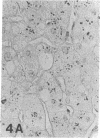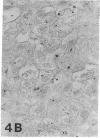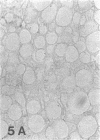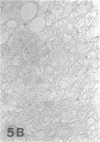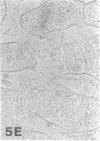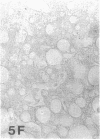Abstract
Acetaldehyde, the toxic product of ethanol metabolism in the liver, covalently binds to a variety of proteins. Recent studies indicate that such binding can stimulate the production of antibodies against the acetaldehyde adducts. We raised rabbit antibodies which recognized various protein-acetaldehyde conjugates but not the corresponding control proteins. Such antibodies were used in immunohistochemical studies to find out whether acetaldehyde-generated epitopes can be detected from liver specimens of 13 human subjects with different degrees of alcohol consumption. While the specimens obtained from alcohol abusers (n = 4) and alcoholics (n = 3) exhibited marked positive staining for acetaldehyde adducts inside the hepatocytes in a granular uneven pattern, the control samples (n = 6) were almost devoid of immunoreactivity. In the alcohol abusers with an early stage of alcohol-induced liver damage, staining was detected exclusively around the central veins. The data indicate that intracellular acetaldehyde adducts occur in the centrilobular region of the liver of individuals consuming excessive amounts of alcohol. Immunohistochemical detection of such adducts may prove to be of value in the early identification of alcohol abuse and in elucidating the mechanisms of alcohol-induced organ damage.
Full text
PDF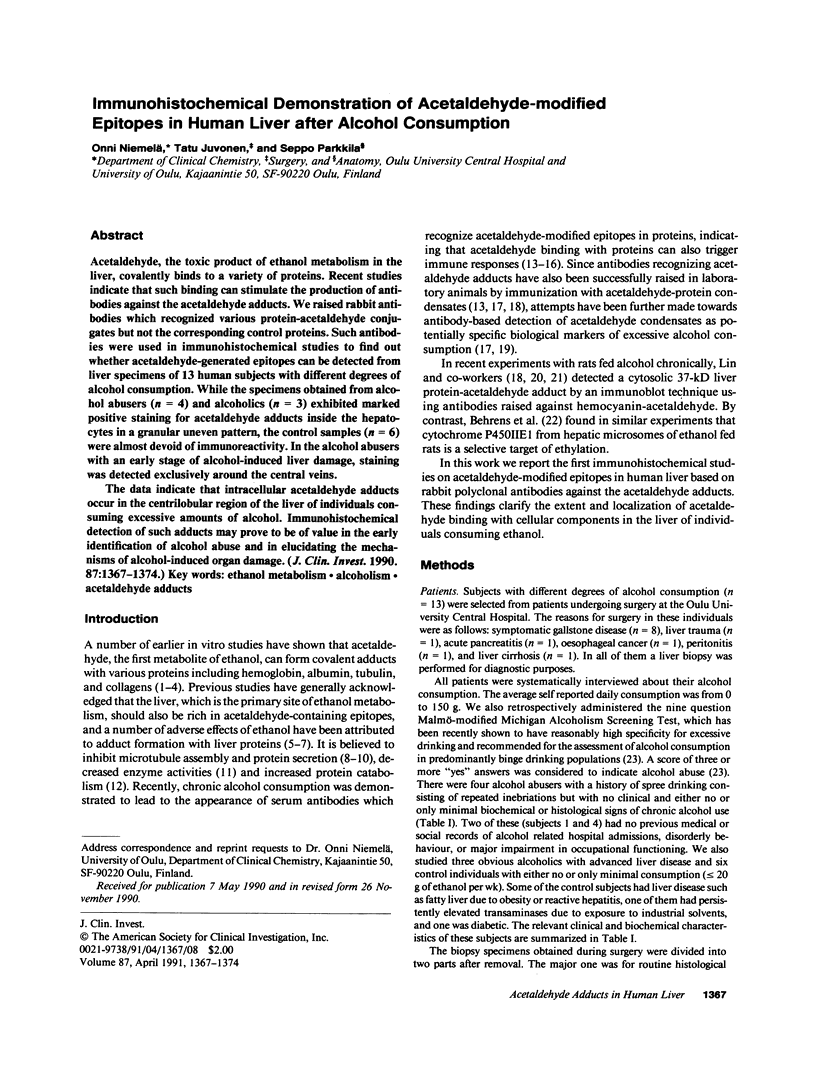
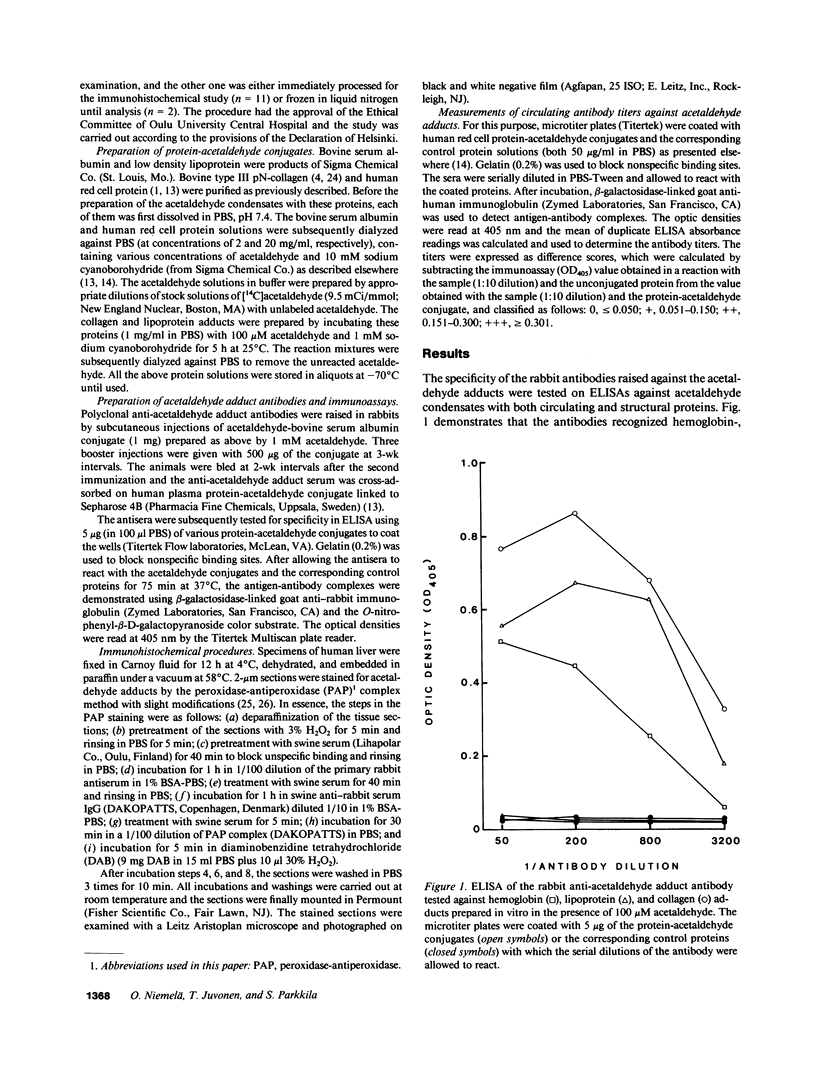

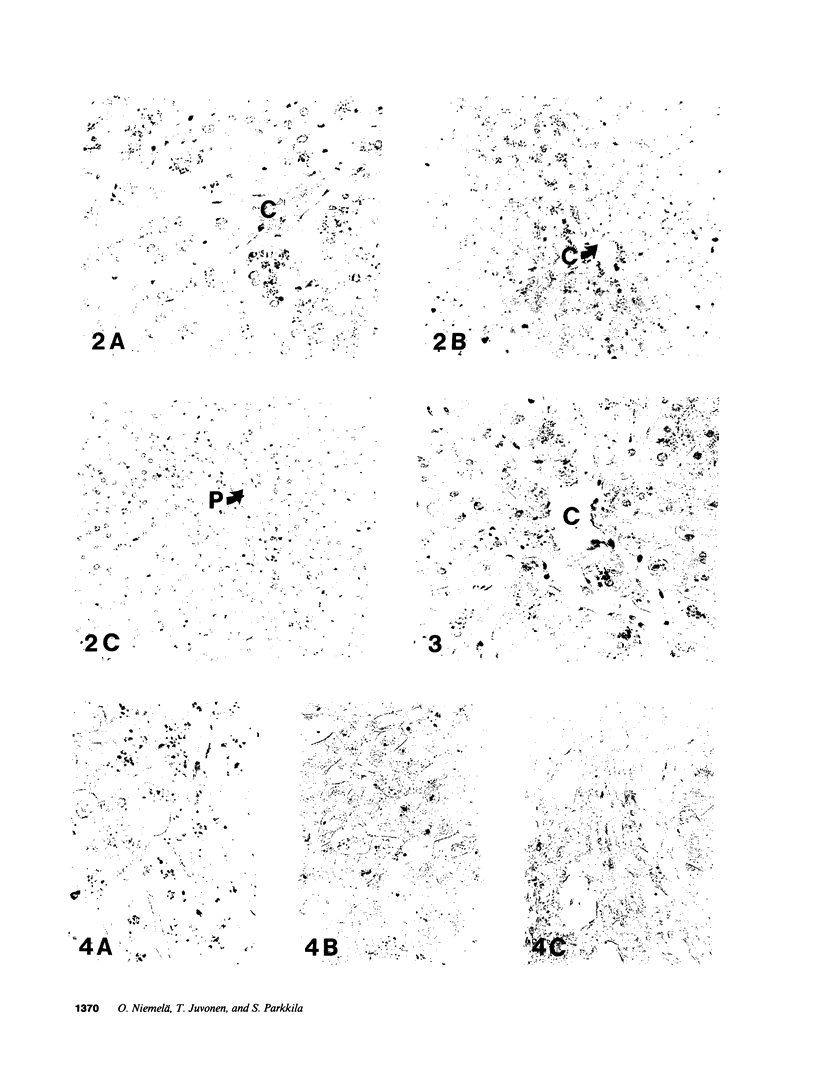
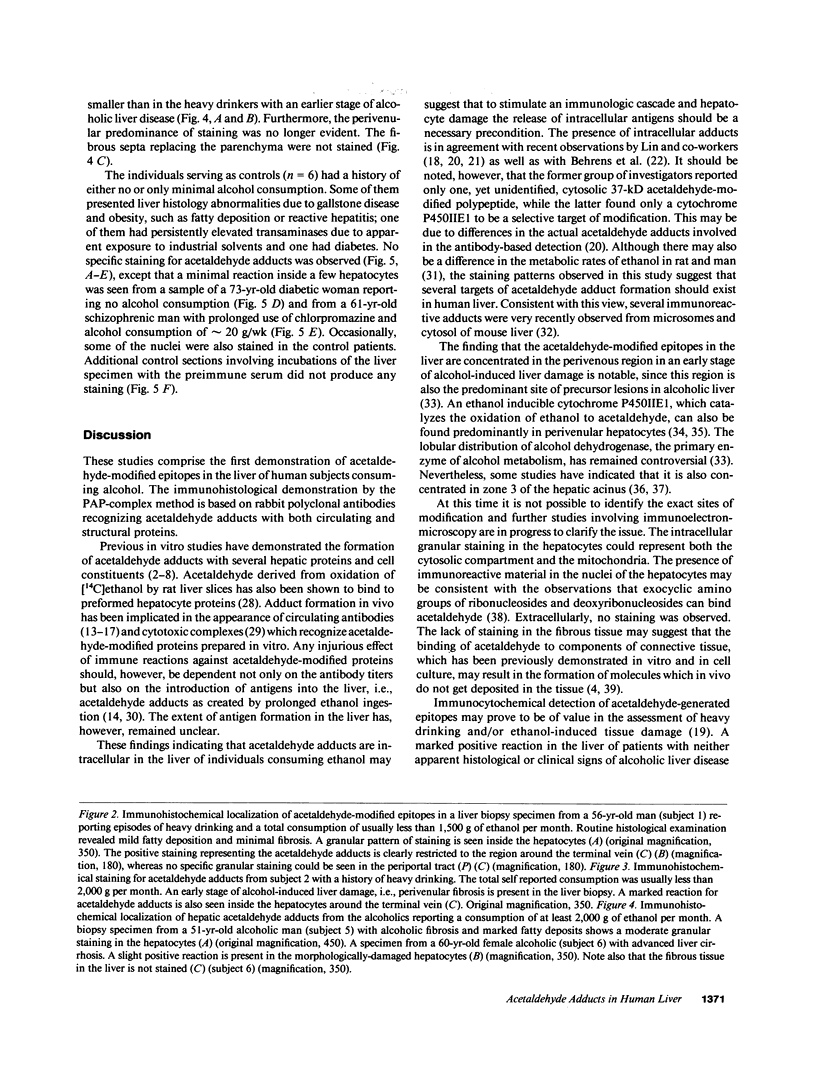
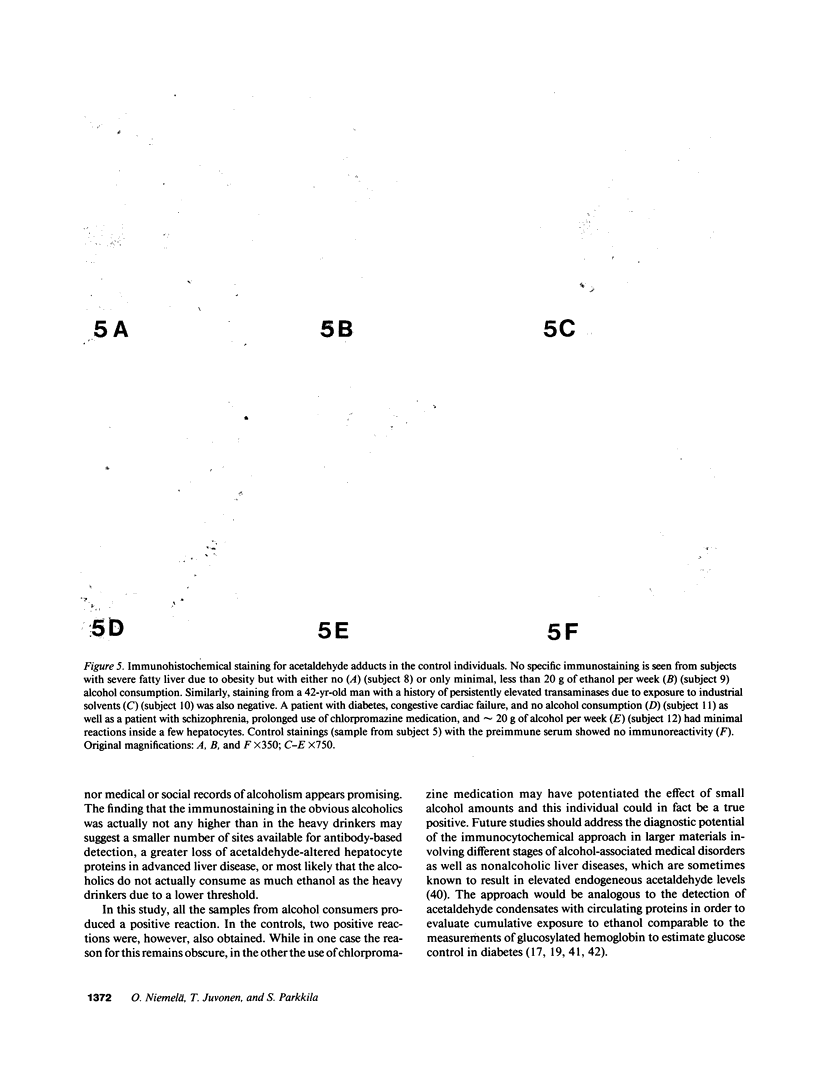

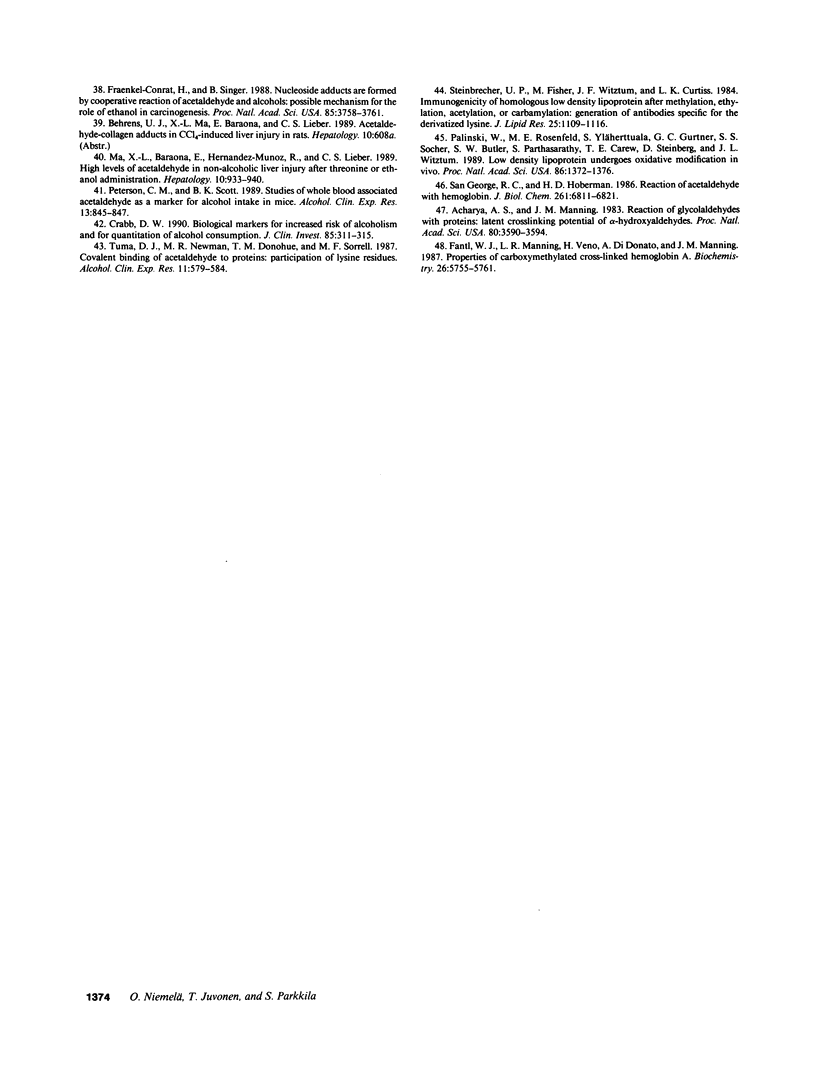
Images in this article
Selected References
These references are in PubMed. This may not be the complete list of references from this article.
- Acharya A. S., Manning J. M. Reaction of glycolaldehyde with proteins: latent crosslinking potential of alpha-hydroxyaldehydes. Proc Natl Acad Sci U S A. 1983 Jun;80(12):3590–3594. doi: 10.1073/pnas.80.12.3590. [DOI] [PMC free article] [PubMed] [Google Scholar]
- Baraona E., Leo M. A., Borowsky S. A., Lieber C. S. Pathogenesis of alcohol-induced accumulation of protein in the liver. J Clin Invest. 1977 Sep;60(3):546–554. doi: 10.1172/JCI108806. [DOI] [PMC free article] [PubMed] [Google Scholar]
- Behrens U. J., Hoerner M., Lasker J. M., Lieber C. S. Formation of acetaldehyde adducts with ethanol-inducible P450IIE1 in vivo. Biochem Biophys Res Commun. 1988 Jul 29;154(2):584–590. doi: 10.1016/0006-291x(88)90180-5. [DOI] [PubMed] [Google Scholar]
- Buehler R., Hess M., Von Wartburg J. P. Immunohistochemical localization of human liver alcohol dehydrogenase in liver tissue, cultured fibroblasts, and HeLa cells. Am J Pathol. 1982 Jul;108(1):89–99. [PMC free article] [PubMed] [Google Scholar]
- Crabb D. W. Biological markers for increased risk of alcoholism and for quantitation of alcohol consumption. J Clin Invest. 1990 Feb;85(2):311–315. doi: 10.1172/JCI114439. [DOI] [PMC free article] [PubMed] [Google Scholar]
- Dole V. P. On the relevance of animal models to alcoholism in humans. Alcohol Clin Exp Res. 1986 Aug;10(4):361–363. doi: 10.1111/j.1530-0277.1986.tb05107.x. [DOI] [PubMed] [Google Scholar]
- Donohue T. M., Jr, Tuma D. J., Sorrell M. F. Acetaldehyde adducts with proteins: binding of [14C]acetaldehyde to serum albumin. Arch Biochem Biophys. 1983 Jan;220(1):239–246. doi: 10.1016/0003-9861(83)90406-x. [DOI] [PubMed] [Google Scholar]
- Donohue T. M., Jr, Tuma D. J., Sorrell M. F. Binding of metabolically derived acetaldehyde to hepatic proteins in vitro. Lab Invest. 1983 Aug;49(2):226–229. [PubMed] [Google Scholar]
- Fantl W. J., Manning L. R., Ueno H., Di Donato A., Manning J. M. Properties of carboxymethylated cross-linked hemoglobin A. Biochemistry. 1987 Sep 8;26(18):5755–5761. doi: 10.1021/bi00392a026. [DOI] [PubMed] [Google Scholar]
- Fraenkel-Conrat H., Singer B. Nucleoside adducts are formed by cooperative reaction of acetaldehyde and alcohols: possible mechanism for the role of ethanol in carcinogenesis. Proc Natl Acad Sci U S A. 1988 Jun;85(11):3758–3761. doi: 10.1073/pnas.85.11.3758. [DOI] [PMC free article] [PubMed] [Google Scholar]
- Hoerner M., Behrens U. J., Worner T. M., Blacksberg I., Braly L. F., Schaffner F., Lieber C. S. The role of alcoholism and liver disease in the appearance of serum antibodies against acetaldehyde adducts. Hepatology. 1988 May-Jun;8(3):569–574. doi: 10.1002/hep.1840080322. [DOI] [PubMed] [Google Scholar]
- Ingelman-Sundberg M., Johansson I., Penttilä K. E., Glaumann H., Lindros K. O. Centrilobular expression of ethanol-inducible cytochrome P-450 (IIE1) in rat liver. Biochem Biophys Res Commun. 1988 Nov 30;157(1):55–60. doi: 10.1016/s0006-291x(88)80010-x. [DOI] [PubMed] [Google Scholar]
- Israel Y., Hurwitz E., Niemelä O., Arnon R. Monoclonal and polyclonal antibodies against acetaldehyde-containing epitopes in acetaldehyde-protein adducts. Proc Natl Acad Sci U S A. 1986 Oct;83(20):7923–7927. doi: 10.1073/pnas.83.20.7923. [DOI] [PMC free article] [PubMed] [Google Scholar]
- Israel Y., Orrego H., Niemelä O. Immune responses to alcohol metabolites: pathogenic and diagnostic implications. Semin Liver Dis. 1988 Feb;8(1):81–90. doi: 10.1055/s-2008-1040530. [DOI] [PubMed] [Google Scholar]
- Izumi N., Sakai Y., Koyama W., Hasumura Y. Clinical significance of serum antibodies against alcohol-altered hepatocyte membrane in alcoholic liver disease. Alcohol Clin Exp Res. 1989 Dec;13(6):762–765. doi: 10.1111/j.1530-0277.1989.tb00417.x. [DOI] [PubMed] [Google Scholar]
- Jennett R. B., Sorrell M. F., Saffari-Fard A., Ockner J. L., Tuma D. J. Preferential covalent binding of acetaldehyde to the alpha-chain of purified rat liver tubulin. Hepatology. 1989 Jan;9(1):57–62. doi: 10.1002/hep.1840090109. [DOI] [PubMed] [Google Scholar]
- Jukkola A., Niemelä O. Covalent binding of acetaldehyde to type III collagen. Biochem Biophys Res Commun. 1989 Feb 28;159(1):163–169. doi: 10.1016/0006-291x(89)92418-2. [DOI] [PubMed] [Google Scholar]
- Lieber C. S. Biochemical and molecular basis of alcohol-induced injury to liver and other tissues. N Engl J Med. 1988 Dec 22;319(25):1639–1650. doi: 10.1056/NEJM198812223192505. [DOI] [PubMed] [Google Scholar]
- Lin R. C., Fillenwarth M. J., Minter R., Lumeng L. Formation of the 37-kD protein-acetaldehyde adduct in primary cultured rat hepatocytes exposed to alcohol. Hepatology. 1990 Mar;11(3):401–407. doi: 10.1002/hep.1840110311. [DOI] [PubMed] [Google Scholar]
- Lin R. C., Lumeng L. Further studies on the 37 kD liver protein-acetaldehyde adduct that forms in vivo during chronic alcohol ingestion. Hepatology. 1989 Nov;10(5):807–814. doi: 10.1002/hep.1840100510. [DOI] [PubMed] [Google Scholar]
- Lin R. C., Lumeng L., Shahidi S., Kelly T., Pound D. C. Protein-acetaldehyde adducts in serum of alcoholic patients. Alcohol Clin Exp Res. 1990 Jun;14(3):438–443. doi: 10.1111/j.1530-0277.1990.tb00501.x. [DOI] [PubMed] [Google Scholar]
- Lin R. C., Smith R. S., Lumeng L. Detection of a protein-acetaldehyde adduct in the liver of rats fed alcohol chronically. J Clin Invest. 1988 Feb;81(2):615–619. doi: 10.1172/JCI113362. [DOI] [PMC free article] [PubMed] [Google Scholar]
- Ma X. L., Baraona E., Hernández-Muñoz R., Lieber C. S. High levels of acetaldehyde in nonalcoholic liver injury after threonine or ethanol administration. Hepatology. 1989 Dec;10(6):933–940. doi: 10.1002/hep.1840100607. [DOI] [PubMed] [Google Scholar]
- Mauch T. J., Donohue T. M., Jr, Zetterman R. K., Sorrell M. F., Tuma D. J. Covalent binding of acetaldehyde selectively inhibits the catalytic activity of lysine-dependent enzymes. Hepatology. 1986 Mar-Apr;6(2):263–269. doi: 10.1002/hep.1840060218. [DOI] [PubMed] [Google Scholar]
- McKinnon G., de Jersey J., Shanley B., Ward L. The reaction of acetaldehyde with brain microtubular proteins: formation of stable adducts and inhibition of polymerization. Neurosci Lett. 1987 Aug 18;79(1-2):163–168. doi: 10.1016/0304-3940(87)90690-2. [DOI] [PubMed] [Google Scholar]
- Medina V. A., Donohue T. M., Jr, Sorrell M. F., Tuma D. J. Covalent binding of acetaldehyde to hepatic proteins during ethanol oxidation. J Lab Clin Med. 1985 Jan;105(1):5–10. [PubMed] [Google Scholar]
- Niemelä O., Klajner F., Orrego H., Vidins E., Blendis L., Israel Y. Antibodies against acetaldehyde-modified protein epitopes in human alcoholics. Hepatology. 1987 Nov-Dec;7(6):1210–1214. doi: 10.1002/hep.1840070607. [DOI] [PubMed] [Google Scholar]
- Nomura F., Lieber C. S. Binding of acetaldehyde to rat liver microsomes: enhancement after chronic alcohol consumption. Biochem Biophys Res Commun. 1981 May 15;100(1):131–137. doi: 10.1016/s0006-291x(81)80073-3. [DOI] [PubMed] [Google Scholar]
- Nuutinen H., Lindros K. O., Salaspuro M. Determinants of blood acetaldehyde level during ethanol oxidation in chronic alcoholics. Alcohol Clin Exp Res. 1983 Spring;7(2):163–168. doi: 10.1111/j.1530-0277.1983.tb05432.x. [DOI] [PubMed] [Google Scholar]
- Palinski W., Rosenfeld M. E., Ylä-Herttuala S., Gurtner G. C., Socher S. S., Butler S. W., Parthasarathy S., Carew T. E., Steinberg D., Witztum J. L. Low density lipoprotein undergoes oxidative modification in vivo. Proc Natl Acad Sci U S A. 1989 Feb;86(4):1372–1376. doi: 10.1073/pnas.86.4.1372. [DOI] [PMC free article] [PubMed] [Google Scholar]
- Parkkila S., Kaunisto K., Rajaniemi L., Kumpulainen T., Jokinen K., Rajaniemi H. Immunohistochemical localization of carbonic anhydrase isoenzymes VI, II, and I in human parotid and submandibular glands. J Histochem Cytochem. 1990 Jul;38(7):941–947. doi: 10.1177/38.7.2113069. [DOI] [PubMed] [Google Scholar]
- Peterson C. M., Scott B. K. Studies of whole blood associated acetaldehyde as a marker for alcohol intake in mice. Alcohol Clin Exp Res. 1989 Dec;13(6):845–848. doi: 10.1111/j.1530-0277.1989.tb00435.x. [DOI] [PubMed] [Google Scholar]
- San George R. C., Hoberman H. D. Reaction of acetaldehyde with hemoglobin. J Biol Chem. 1986 May 25;261(15):6811–6821. [PubMed] [Google Scholar]
- Savolainen M. J., Baraona E., Lieber C. S. Acetaldehyde binding increases the catabolism of rat serum low-density lipoproteins. Life Sci. 1987 Mar 2;40(9):841–846. doi: 10.1016/0024-3205(87)90032-4. [DOI] [PubMed] [Google Scholar]
- Seppä K., Sillanaukee P., Koivula T. The efficiency of a questionnaire in detecting heavy drinkers. Br J Addict. 1990 Dec;85(12):1639–1645. doi: 10.1111/j.1360-0443.1990.tb01654.x. [DOI] [PubMed] [Google Scholar]
- Smith S. L., Jennett R. B., Sorrell M. F., Tuma D. J. Acetaldehyde substoichiometrically inhibits bovine neurotubulin polymerization. J Clin Invest. 1989 Jul;84(1):337–341. doi: 10.1172/JCI114159. [DOI] [PMC free article] [PubMed] [Google Scholar]
- Sorrell M. F., Tuma D. J. The functional implications of acetaldehyde binding to cell constituents. Ann N Y Acad Sci. 1987;492:50–62. doi: 10.1111/j.1749-6632.1987.tb48652.x. [DOI] [PubMed] [Google Scholar]
- Steinbrecher U. P., Fisher M., Witztum J. L., Curtiss L. K. Immunogenicity of homologous low density lipoprotein after methylation, ethylation, acetylation, or carbamylation: generation of antibodies specific for derivatized lysine. J Lipid Res. 1984 Oct;25(10):1109–1116. [PubMed] [Google Scholar]
- Stevens V. J., Fantl W. J., Newman C. B., Sims R. V., Cerami A., Peterson C. M. Acetaldehyde adducts with hemoglobin. J Clin Invest. 1981 Feb;67(2):361–369. doi: 10.1172/JCI110043. [DOI] [PMC free article] [PubMed] [Google Scholar]
- Tsutsumi M., Lasker J. M., Shimizu M., Rosman A. S., Lieber C. S. The intralobular distribution of ethanol-inducible P450IIE1 in rat and human liver. Hepatology. 1989 Oct;10(4):437–446. doi: 10.1002/hep.1840100407. [DOI] [PubMed] [Google Scholar]
- Tuma D. J., Newman M. R., Donohue T. M., Jr, Sorrell M. F. Covalent binding of acetaldehyde to proteins: participation of lysine residues. Alcohol Clin Exp Res. 1987 Dec;11(6):579–584. doi: 10.1111/j.1530-0277.1987.tb00178.x. [DOI] [PubMed] [Google Scholar]
- Wickramasinghe S. N., Gardner B., Barden G. Cytotoxic protein molecules generated as a consequence of ethanol metabolism in vitro and in vivo. Lancet. 1986 Oct 11;2(8511):823–826. doi: 10.1016/s0140-6736(86)92866-7. [DOI] [PubMed] [Google Scholar]
- Yamauchi M., Potter J. J., Mezey E. Lobular distribution of alcohol dehydrogenase in the rat liver. Hepatology. 1988 Mar-Apr;8(2):243–247. doi: 10.1002/hep.1840080209. [DOI] [PubMed] [Google Scholar]







